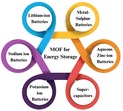Owing to the characteristics of metal–organic frameworks (MOFs) and their variants, such as large specific surface area, high porosity, tunable structure, and ease of structural modulation, MOFs have been extensively used as electrode materials, separators, electrocatalysts, and other components of energy storage systems. Nevertheless, there are several practical issues associated with the use of MOFs that have not yet been fully resolved. The current research progress in incorporating MOFs and their derived materials into energy storage devices, including alkali-metal-ion batteries, metal sulphur batteries, aqueous zinc-ion batteries, and supercapacitors, is presented in this paper. It also provides design solutions to some major problems, such as dendrite growth and shuttle effects, which are almost always observed in secondary batteries. In addition, the design ideas for MOF-derived carbon material heterostructures and metal compound structure modification are summarized. This review provides a comprehensive compilation of the most recent studies in the domain of energy storage and conversion. Finally, the intrinsic regulation of MOF precursors and modification strategies of the materials are summarized and prospected.
